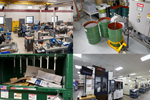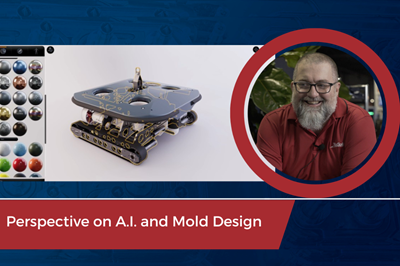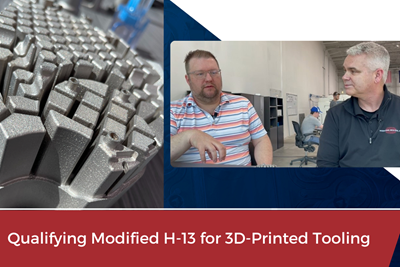Advancing Moldmaking and Plastics: Trends in 3D Printing, Automation and Sustainability
NPE 2024 showcased the latest trends and technologies in innovation, efficiency and sustainability for moldmakers and molders, featuring advancements in 3D printing, automation, design and virtual reality/augmented reality/artificial intelligence.
As usual, moldmaking was on display during NPE. Presses across the show floor ran molds demonstrating sophisticated, innovative mold designs and manufacturing processes for higher efficiency, precision and quality. They included thin-wall container and lid family molds producing components simultaneously, shuttle mold systems for efficient production, fully automated molds with multiple cavities and cold runner systems, metal 3D-printed tools molding medical device prototypes and real-time monitoring of molds for quality control and efficiency. However, on top of that, exhibitors showcased product, equipment and service solutions on everything from additive manufacturing, software, mold materials, hot runners and mold components to surface treatment, maintenance, repair and training.

Having had time to reflect on NPE 2024 and gather feedback from MoldMaking Technology readers, I want to share a brief review of five trends I observed on the show floor and highlight some of the companies leading these innovations.
3D Printing
The overwhelming interest from mold builders who attended NPE was in 3D printing (3DP). It is clear from the 3DP companies exhibiting that this technology has transitioned from initial excitement to a phase of maturity and acceptance as it has become more justifiable to implement. Companies have learned to effectively integrate 3D printing into their operations, solving real problems and proving the technology's value and reliability. This broader adoption spans multiple industries where 3DP is used for creating complex geometries and multi-material tooling components.
Efficient Engineering and Expertise
Advancements in engineering were evident as well. Companies are using imaging and augmented reality technologies in their operations, suggesting a trend towards digitalization and enhanced visualization in moldmaking. For example, enhanced automation and use of Virtual Reality (VR), Augmented Reality (AR) and Artificial Intelligence (AI) to improve 3D mold design and maintenance to streamline workflows, reduce errors, increase productivity and improve mold design accuracy. AR and VR technologies are answering the call for a skilled workforce trained for emerging job roles as well by providing immersive training experiences. These engineering advancements also include developments in mold component and hot runner technology to improve control, precision and efficiency as well as to increase overall part design freedom and speed to market.
Data Monitoring
Data-driven decision-making and AI are reshaping mold manufacturing. The integration of cloud-based mold monitoring, AI-driven automation and data analytics is becoming standard practice, driving significant improvements in operational efficiency and quality. Monitoring systems provide real-time insights, enabling predictive maintenance and optimized performance via cloud-based systems for comprehensive asset management.
Sustainability and Efficiency
Sustainability remains a focus, with companies focusing on how their products and processes contribute to a more sustainable economy, such as by using bio resins, employing co-injection molding and lightweighting via mold designs that reduce material usage while maintaining strength and quality. For example, hot runner technology is being designed to address the specific requirements of bio resins, reflecting a broader trend towards sustainability in materials.
Training and Education
The industry continues to emphasize training and education to ensure a skilled workforce for the future with a focus on mentoring programs to transfer knowledge and develop future engineering talent. Collaborative programs with technical education institutions and eLearning initiatives are critical components of this effort. Programs designed to attract, train and retain talent are essential. Companies are leveraging eLearning for sustainability training and to bridge knowledge gaps while also establishing partnerships with educational institutions to help align curricula with industry needs, preparing students for careers in moldmaking.
These technologies and trends are just a few I was able to observe during my very busy week at NPE that are helping to reshape mold manufacturing. The MMT team is working on following up on many of these trends in future content to do our part in helping to advance moldmaking.
Related Content
A 3D Printing Retrospective
A personal review of the evolution of 3D printing in moldmaking throughout the past 25 years.
Read MoreLarge Hybrid Steel Insert Solves Deformation, Dimensionality, Cycle Time Problems
DMLS printers using metal additive powders selected by Linear AMS to produce high-quality, accurate, consistent 3D-printed mold components with certification and traceability.
Read MoreMMT Chats: California Mold Builder Discusses the Difficulties with Silicone Molding and the Power of the Magic 8 Ball
MoldMaking Technology Editorial Director Christina Fuges sits down with M.R. Mold President and Owner, Rick Finnie, to discuss how he began his moldmaking career, M.R. Mold's LSR Education, and the struggles of working with silicone. This episode is brought to you by ISCAR with New Ideas for Machining Intelligently.
Read MoreThe Connector Conundrum: 3D Printed Mold Tooling’s Role in Innovation
ReelView Fishing faced an electronics obstacle in the development of its new technology for underwater video. Additive manufacturing for moldmaking enabled the speed necessary to iterate to a solution.
Read MoreRead Next
VIDEO: Perspective on A.I. and Mold Design
Bill Genc of TopSolid shares his perspective on the benefits of and barriers to using artificial intelligence in mold design.
Read MorePerspectives on Sustainability in Mold Building: A Diverse Outlook
In conversations with individuals involved in the mold building industry, a variety of perspectives on sustainability emerged, showcasing the multifaceted nature of the term.
Read MoreVIDEO: Qualifying Modified H-13 for 3D-Printed Tooling
Next Chapter Manufacturing and International Mold Steel discuss their partnership to qualify a modified H-13 for tooling applications.
Read More






















